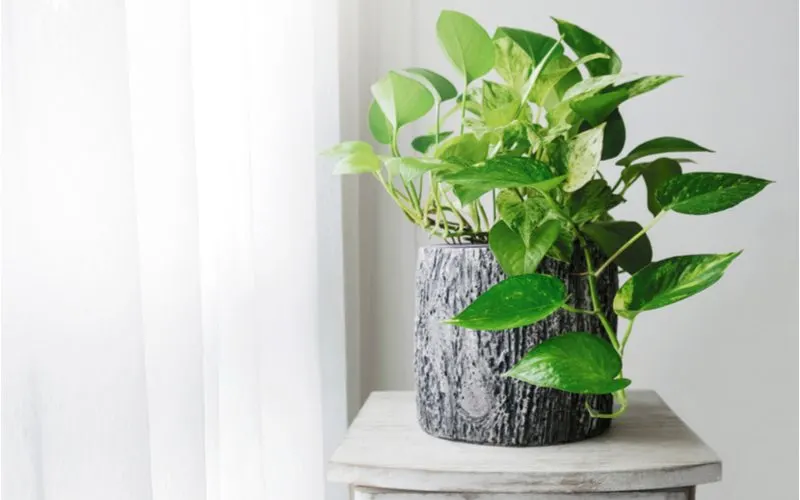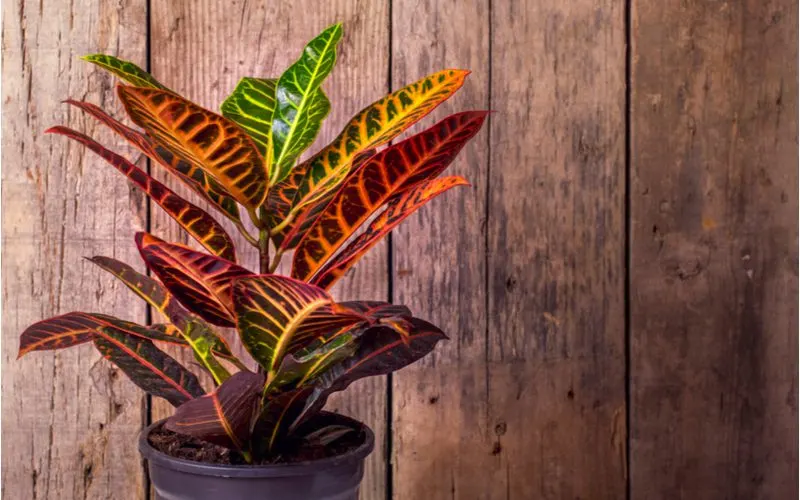Tropical house plants have a unique way of brightening up a space while also adding a personalized touch like none other.
Anyone can have a succulent or a fern, but a tropical plant shows style and pizzazz.
If you’re looking to add some life to your home, check out these 15 incredible tropical house plants.
15 Tropical House Plants You’ll Love
Look no further for the exotic and tropical style you’ve been craving.
These tropical plants are beautiful and easy to grow, so even you can’t kill them!
1. Golden Pothos

ArtBackground/Shutterstock
Native to South Asia, the golden pothos is a stunning plant whose leaves actually resemble the shape of a heart.
The plant’s name is appropriate, given that its leaves are green with golden accents. Golden pothos plants are ideal tropical house plants because they do well in medium to low lighting.
You also only need to water them when the top few inches of their soil become dry, so every few days or so.
A note of warning: not only do these plants grow quite large (they can get up to ten feet high!), but they’re also known to be toxic to cats and dogs.
2. Caladium

Firn/Shutterstock
Caladium plants are the perfect indoor tropical plants for those looking for a pop of color to add to their space.
These perennials don’t have flowers, but their bold colors make them seem like they do.
They boast large leaves that display greens, reds, and pinks in veined and striped patterns.
Caladiums are partial to indirect sunlight, so it’s easy to keep them inside. But like the golden pothos, be sure to keep these toxic plants away from your pets.
3. Horsehead Philodendron

Jamaludinyusuppp/Shutterstock
The horsehead philodendron is a perennial climber, which means that it grows as a vine and will climb objects that you put near it. This unique plant is named for the shape of its leaves.
The boldly green tendrils actually look very similar to a horse’s head, though some people think they look more like a violin.
Horsehead philodendron plants are perfect for hanging pots, as their vines will spill over nicely for a filling effect. They’re super low-maintenance and require little watering.
4. Elephant Ear

Rattiya Lamrod/Shutterstock
The elephant ear is another plant named for leaves that resemble an animal.
This plant sprouts very large leaves that look surprisingly similar to those of an elephant! Elephant ear plants are very common, fast-growing plants.
They’re great for having a dramatic effect on any room you place them in, with leaves that can grow as long as two feet.
Elephant ears do like a lot of sun, so while you can keep them in your home, it’s important to place them in a sunny spot. They also prefer moist soil, so it’s best to water them every day.
5. Ficus Benjamina

New Africa/Shutterstock
Who wants a boring old Ficus when you can have the exotic and cool Ficus Benjamina? Ficus Benjamina is an evergreen shrub with long-tipped leaves and drooping branches.
This is a larger house plant that can grow up to 30 feet in nature, though the ones you keep potted in your house aren’t likely to grow nearly that high.
The Ficus Benjamina enjoys high sunlight and dry soil, and it does great with a lot of pruning.
6. Moth Orchid

Serhii Ivashchuk/Shutterstock
Orchids are so classy and timeless that you might forget that they’re actually considered tropical plants.
The moth orchid is one of the easiest orchids to grow and care for in your home. They’re incredibly inexpensive, and you can likely find them in your local supermarket.
Their stunning blooms come in blues, greens, reds, pinks, whites, and more, and they last for a long time.
Be sure to give your orchid plenty of sunlight, and you’ll be rewarded with some truly stunning flowers.
7. Majestic Palm Tree

Artem Tetiana/Shutterstock
Make your home look like the streets of Florida or a tropical island vacation with a majestic palm tree.
Although there are several species of palm trees that you can grow indoors, the majestic palm is one of the best choices.
Majestic palms are very tolerant of low sunlight, so you don’t have to be too particular about where you put them.
They’re also very slow growers, meaning you won’t need to worry about them growing through your roof anytime soon.
Your palm will eventually get too big for the indoors, though, so eventually it’ll have to go outside.
8. Croton

Mehmet Gokhan Bayhan/Shutterstock
Croton plants are like fall in a pot with all of their bright reds, greens, yellows, and oranges.
These tropical bushes boast multi-colored leaves that easily enhance the look of any indoor space. The croton plant can grow as high as six feet tall, so be prepared to let it thrive.
These plants need lots of sunlight to remain healthy, and they do best with nutrient-rich soil.
Be sure to keep their soil moist but not overwatered. Poor maintenance of a croton plant can cause it to rot and lose its leaves.
9. Dumb Cane

CoinUp/Shutterstock
Dumb cane is typically what most people picture when they think of the average house plant. In an indoor setting, you can expect this plant to grow up to five feet tall.
The plant, which is technically called Dieffenbachia, was given the name dumb cane because it’s highly toxic to people and pets, so keep that in mind.
This seasonal bloomer prefers partial shade or indirect light and needs well-draining soil and pot to live in.
10. Canna Lily

Taweesak Sriwannawit/Shutterstock
Canna lilies are well-known flowers adored for their beautiful tropical colors, including red, yellow, orange, pink, and white.
As stunning as these plants are, they’re actually very easy to grow and care for. Canna lilies prefer full sun exposure and need moist soil that drains well.
Once they sprout, it only takes a bit longer for them to grow and bloom their first flowers.
You can expect a mature canna lily to be anywhere from 1 to 8 feet tall, though indoor plants will likely stay on the smaller side.
11. Bird of Paradise

Dzung Vu/Shutterstock
There’s something about tropical plants and their resemblance to real-life animals, huh?
The bird of paradise flower is now different. Just take a look at this picture and notice how much this flower looks like a brightly colored bird, and you’ll see what we mean.
Bird of Paradise flowers are quite distinctive plants with bright orange or white petals. They enjoy a lot of sun exposure and bloom in the late winter or early spring.
The bird of paradise plant grows pretty quickly and will remain upright up to 12 to 18 inches tall.
Because they have such thin stalks, they’re susceptible to breakage in rowdy environments. Be sure to keep them in a spot where no one bumps into them!
12. Fiddle Leaf Fig

Kowit Phatipreechakul/Shutterstock
The fiddle leaf fig is yet another large statement plant that works well to fill large spaces with its humongous leaves.
This tropical plant is a popular indoor tree that displays large, glossy leaves and looks absolutely stunning in living rooms, bedrooms, and dining rooms alike.
When planted in a floor pot, you can expect your fiddle leaf fig to grow about six feet tall. But some of these plants reach a whopping ten feet.
That’s still okay for indoor spaces, as long as you have the room. Fiddle-leaf figs can flower, but they rarely do when kept indoors.
They’re great indoor plants, as they do just fine with partial shade. Keep their soil moderately moist and enjoy their gorgeous, full leaves.
13. Monstera Deliciosa

Sozina Kseniia/Shutterstock
If you’re looking for one plant to serve as the statement piece for a room, look no further than the monstera deliciosa.
These tropical plants display a unique, split-leaf pattern that gives them the nickname the Swiss-cheese plant.
The all-green plant looks wonderful in decorative pots and baskets and is a well-loved favorite of interior designers.
The heart-shaped leaves can grow as long as three feet, and the plant can boast cream-colored flowers during the mid-summer. It enjoys indirect sunlight and partial shape and is toxic to dogs and cats.
14. Anthurium

Farhad Ibrahimzade/Shutterstock
The anthurium plant is a smaller tropical plant that quickly adds a splash of color to any room.
This perennial plant is native to Central America and the Caribbean, and its colors simply scream “warm climate.”
A popular house plant, the anthurium grows fairly slowly. Its nickname is the flamingo flower, as it commonly has bright red flower spikes.
However, the plant can also show colors of green, white, or yellow. Anthurium plants are climbers, but most people choose to keep them in pots when kept indoors.
They bloom throughout the year, and while they enjoy a lot of sunlight, too much can cause them to burn, so be watchful of this.
Anthuriums are toxic to both humans and pets; enjoy their colors, but keep them out of reach if you have cats, dogs, or young children.
15. Bromeliad

Nippich Somsaard/Shutterstock
Bromeliad plants make it easy to add a tropical touch to any space, so long as they have access to bright, indirect sunlight.
These plants grow in layers of long, thin leaves and, once they reach maturity, bloom flowers in reds, oranges, purples, greens, and yellows.
Unlike many of the others on our list, bromeliads don’t get excessively large and can make a nice plant for kitchen window sills or bedroom shelves.
They grow slowly and are fairly tolerant of changes in temperature and feeding, so they’re perfect for forgetful plant owners.
Things to Consider
Buying a tropical house plant may sound as simple as going out and buying the prettiest one, but there are a few things you should keep in mind before you do so:
- Keep in mind the toxicity of plants if you have cats, dogs, or young children
- Some tropical house plants grow quite large, so be sure to plan space for their growth
- Choose plants that fit your lifestyle; if you can’t dedicate time to maintenance, get a low-maintenance plant
- You can add to the appearance of your plant by choosing a pot that matches your home décor
So long as you keep these things in mind, you should have no problem finding a tropical plant that matches both your vibe and your lifestyle.
What’s Your Favorite Tropical House Plant?

JulieK2/Shutterstock
Tropical house plants give homeowners and renters the opportunity to step away from the average plants and brighten up their homes with unique focal points.
The plants above feature some massive leaves, bright colors, and creative shapes that are sure to customize your space and grab the attention of your guests.
Consider getting yourself one of the plants we’ve talked about today, but keep in mind their care instructions, toxicity, and size before you do!

